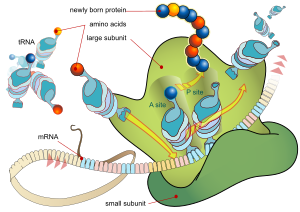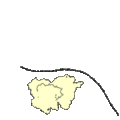Translation (genetics) facts for kids
Translation is a super important step in how your body makes proteins. Think of it like decoding a secret message! It's the second part of a bigger process called protein biosynthesis, which is all about building proteins. This whole process is also part of how your genes work, known as gene expression.
Before translation can happen, a few things need to come first:
- First, there's transcription. This is when a copy of a gene's instructions is made from DNA into a special molecule called RNA. This RNA copy has parts called introns and exons.
- Next, RNA splicing happens. Tiny machines called spliceosomes cut out the "junk" parts (introns).
- What's left are the important "exon" parts, which are then put together to form the final message, called messenger RNA (mRNA).
In living things with a nucleus (like humans and animals, called eukaryotes), translation happens in special places. These are the ribosomes, which float around in the cell's jelly-like cytoplasm or are attached to a network called the endoplasmic reticulum. For tiny living things like bacteria, which don't have a nucleus, translation happens right in their cytoplasm.
Ribosomes are like tiny factories made of two main pieces: a small part and a large part. These two parts come together around the mRNA molecule. The mRNA carries the specific instructions, like a recipe, for making a particular polypeptide chain. This recipe originally came from your DNA and was copied by the mRNA. A polypeptide chain can be a whole protein by itself, or it might be just one piece that needs to join with other pieces to make a complete protein. After it's made, the polypeptide also needs to fold into the correct shape to work properly as a protein.
To build the protein, tiny molecules called tRNAs (transfer RNAs) bring the correct amino acids to the ribosome. Each tRNA has a special "key" called an anticodon. This key matches up with a specific "lock" on the mRNA called a codon. Every tRNA carries a specific amino acid, and its anticodon always goes with that same amino acid.
When a tRNA's anticodon matches up with an mRNA codon, the amino acid it's carrying gets released from the tRNA. Then, it connects to the amino acid that was brought by the tRNA before it. This way, a chain of amino acids starts to grow.
Think of a ribosome like a sewing machine, stitching together amino acids one by one based on the mRNA's pattern. Many ribosomes can work together on the same mRNA. Sometimes, these ribosomes attach to the outer surface of the rough endoplasmic reticulum. Any proteins they make often go inside the endoplasmic reticulum. From there, they might be put into small bubbles called vesicles. These vesicles then carry the proteins to other parts of the cell, or even send them outside the cell to do their jobs.
How Proteins Are Made: The Four Steps
Making proteins through translation happens in four main steps. These steps describe how the chain of amino acids (the polypeptide) gets longer and then stops.
- Activation: This is the "getting ready" step. In this stage, the correct amino acid is chemically attached to its matching transfer RNA (tRNA) molecule. When a tRNA has an amino acid connected to it, we say it's "charged."
- Initiation: This is the "starting" step. Here, the small part of the ribosome connects to the beginning (the 5' end) of the mRNA molecule. Special helper molecules called initiation factors help this connection happen.
- Elongation: This is the "making longer" step. During elongation, the amino acids that are brought by the "charged" tRNAs are linked together one by one. This forms the growing polypeptide chain.
- Termination: This is the "stopping" step. (This step was not detailed in the original text but is the fourth stage of translation).
Some antibiotics (medicines that fight infections) work by stopping translation. This is because the ribosomes in bacteria (prokaryotic ribosomes) are a bit different from the ribosomes in human cells (eukaryotic ribosomes). So, antibiotics can kill bacteria by stopping their protein-making process without harming the human body's own cells. For example, an antibiotic you take might stop the bacteria making you sick, but it won't hurt your own cells.
- Champe, Pamela C. Harvey, Richard A. and Ferrier, Denise R. 2005. Lippincott's illustrated reviews: Biochemistry 3rd ed, Lippincott Williams & Wilkins. ISBN: 0-7817-2265-9.
- Nelson, David L. Cox, Michael M. and Lehninger, Albert L. 2005. Lehninger principles of biochemistry 4th ed, Freeman. ISBN: 0-7167-4339-6.
Images for kids
-
A ribosome translating a protein that is secreted into the endoplasmic reticulum. tRNAs are colored dark blue.
See also
 In Spanish: Traducción (genética) para niños
In Spanish: Traducción (genética) para niños




